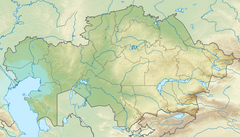| Akbastau Ақбастау | |
|---|---|
 Sentinel-2 image of the confluence of rivers Akbastau (left) and Nura (right). | |
| Location | |
| Countries | Kazakhstan |
| Physical characteristics | |
| Source | Zhaksy Karazhal Kazakh Uplands |
| • coordinates | 49°08′44″N 74°12′37″E / 49.14556°N 74.21028°E |
| • elevation | ca 850 metres (2,790 ft) |
| Mouth | Nura |
• coordinates | 49°36′39″N 74°19′44″E / 49.61083°N 74.32889°E |
• elevation | 624 metres (2,047 ft) |
| Length | 83 km (52 mi) |
| Basin size | 1,570 km2 (610 sq mi) |
| Discharge | |
| • average | 0.18 m3/s (6.4 cu ft/s) |
The Akbastau (Kazakh: Ақбастау; Russian: Ақбастау) is a river in Karkaraly District, Karaganda Region, Kazakhstan. It is 83 kilometres (52 mi) long and has a catchment area of 1,570 square kilometres (610 sq mi).[1][2]
Course
[edit]The Akbastau has its sources in a spring of the northern slopes of Zhaksy Karazhal mountains, at the northern end of Shet District. It heads northwards as a mountain river, forming rapids within a narrow valley. Towards the end it enters a floodplain and its channel divides into branches and becomes sinuous, flowing roughly northwards all along. Finally it reaches the left bank of river Nura close to the western slopes of Mount Yegizkyzyl.[1][3][2]
The Akbastau is fed by snow and groundwater. It is frozen between early December and mid-April. Its main tributaries are the Ainasu and Kamystybulak from the left, and the Kaskakudyk from the right. The water of the river stays fresh all year round. [2][3][4]
Ecology
[edit]The river basin is used as pasture for local cattle. Grasses, willow thickets, fescue and sedges grow near the banks.[4]
See also
[edit]References
[edit]- ^ a b Google Earth
- ^ a b c "M-43 Topographic Chart (in Russian)". Retrieved 12 April 2024.
- ^ a b Kazakhstan National Encyclopedia Vol. 1 / Ch. ed. A. Nysanbayev. — Almaty: « Kazakh encyclopedia» , 1998 ISBN 5-89800-123-9
- ^ a b Karaganda Region Encyclopedia. - Almaty: Atamura, 2006. ISBN 9965-34-515-5

Well, that’s interesting to know that Psilotum nudum are known as whisk ferns. Psilotum nudum is the commoner species of the two. While the P. flaccidum is a rare species and is found in the tropical islands. Both the species are usually epiphytic in habit and grow upon tree ferns. These species may also be terrestrial and grow in humus or in the crevices of the rocks.
View the detailed Guide of Psilotum nudum: Detailed Study Of Psilotum Nudum (Whisk Fern), Classification, Anatomy, Reproduction